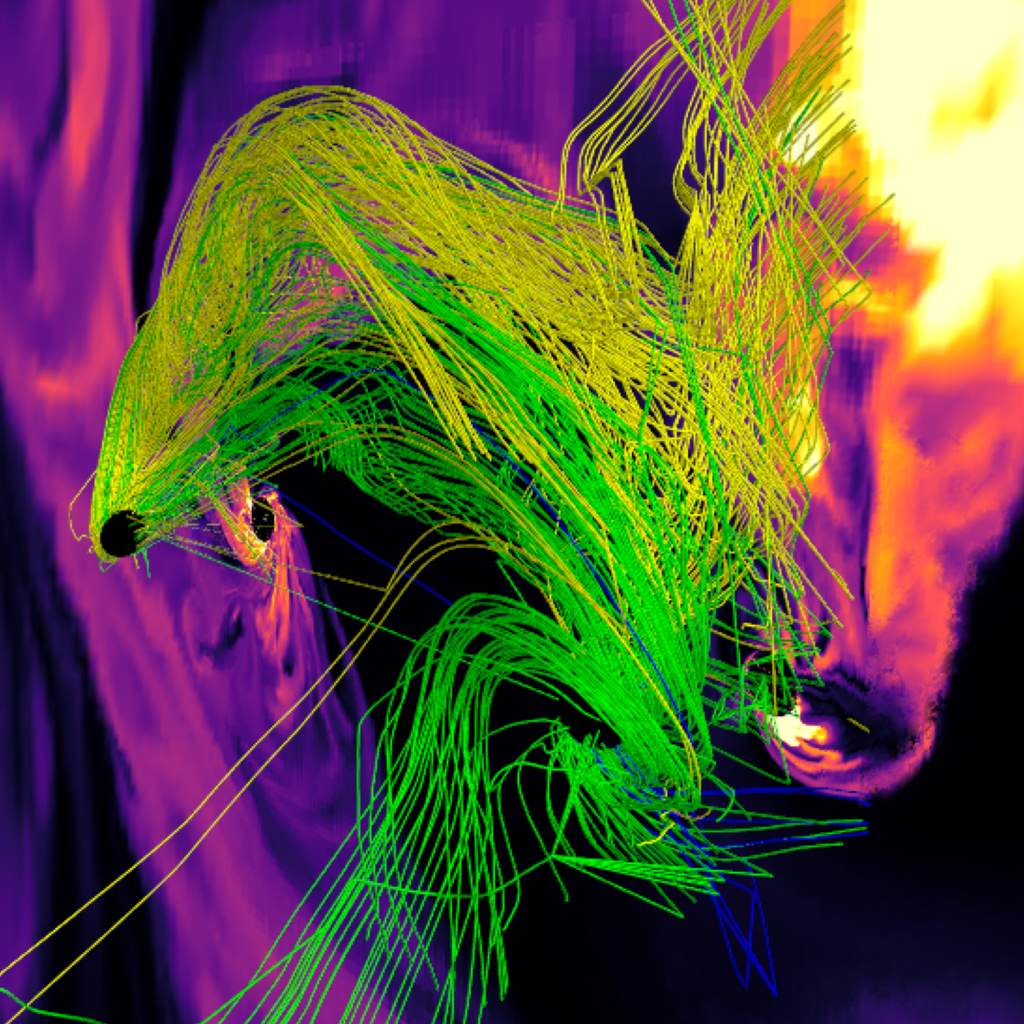Magnetized Plasma around Merging Black Holes Shines and Burst like the Corona of the Sun

Three-dimensional visualization of the magnetic field in the simulation during a “bridge” eruption event. Green lines denote the magnetic field that connects the two black holes while the yellow lines represent magnetic fields that have “broken off” in a violent flaring event. (Created by Sean Ressler)
What happens when the supermassive black holes at the centre of galaxies collide? This is the question explored in a new article by CITA Postdoctoral fellow Sean Ressler, CITA faculty Bart Ripperda, CITA National Fellow Luciano Combi (University of Guelph/Perimeter Institute, and Caltech faculty Elias Most that just came out in the Astrophysical Journal Letters.
At the centre of almost every large galaxy in the Universe is a supermassive black hole that has helped shape its evolution throughout its lifetime. When two galaxies collide, the massive black holes in their center can form a binary system surrounded by strongly magnetized gas. As outlined in their paper, the authors perform novel computer simulations of binary black holes in a magnetized plasma showing that the system can shine and burst in a similar way as the corona of the sun.
Supermassive binary black holes in galactic centres are particularly important for studying the most extreme gravitational events in the universe. As potential multimessenger sources of both gravitational waves and electromagnetic radiation, binaries can be “seen” as light (electromagnetic radiation) and, in coming years, will also be “heard” through the ripples in space and time called gravitational waves. Space-based detectors targeting these waves will offer additional insight into these systems that can be combined with more traditional observations to deepen our understanding of such unique environments.
“It is an exhilarating time to be studying these supermassive binary systems because we are truly only in the early stages of modeling their interactions with surrounding matter; each step forward is groundbreaking. As a community we have spent most of our time modeling single black hole sources (like those that have recently been imaged by the Event Horizon Telescope) and in a way this is the next step. The ground was laid by a handful of pioneering simulations, but we are now able to start pushing towards more realistic regimes and making robust predictions about what we might see,” shares first author and CITA Postdoctoral fellow Dr. Sean Ressler.
Since gravitational wave detectors are not able to precisely locate these supermassive objects, it is imperative to have solid predictions about how such binary systems would appear in the sky. To make such predictions, the authors use high-performance numerical simulations of hot, magnetized gas around binary black holes to identify two ways in which galaxies containing such binaries may shine differently than galaxies containing a single supermassive black hole. The first way involves the collision of the two jets: beams of ultra-fast, highly magnetized outflow accelerated by the rotation of each black hole. These collisions are very similar to how loops of magnetic field poking through the surface of the sun often collide and generate solar flares. The second way involves “bridges” of magnetic field lines that can spontaneously form between the two black holes. As the black holes orbit around each other, these bridges get severely twisted until they ultimately snap, releasing a large amount of energy associated with a burst of light. This is similar to the so-called “coronal mass ejections” in the sun, where bridges form between two moving spots on the solar surface.
“For me, it was most exciting to see the same mechanisms that cause extreme events in the sun show up in binary black hole systems. On the one hand, you have the most well-studied and (if I may say) important object in space, and on the other, you have something that seems to have appeared straight out of a sci-fi. But physics is universal, so even the most extreme or remotest parts of the universe are governed by the same physical laws as our local solar system. In fact, this is not the first time that black hole astronomers have learned something from solar astronomers!”, continues Dr. Ressler.
These findings will help future missions identify supermassive black hole binary pairs and link gravitational wave sources with visual counterparts in the sky. As another one of the contributors, CITA National Fellow Luciano Combi, affirms:
“Our new state-of-the-art simulations led and developed by Dr. Ressler represent a major step forward in modeling the plasma around supermassive binary black holes. Thanks to our team’s diverse expertise in magnetohydrodynamics, plasma physics, and curved spacetime, we have devised a few novel emission mechanisms occurring around binaries; surprisingly, these are analogous to phenomena occurring in our sun! Our hope is that these theoretical results will help detect pairs of giant black holes lurking in the center of galaxies.”
The video sequence above contains a three-dimensional visualization of the two jets in the simulation (in orange and yellow) as they spiral around each other and collide, potentially releasing a large amount of energy in the form of light. (Created by Sean Ressler)
Sean M. Ressler, Luciano Combi, Bart Ripperda, Elias R. Most, ‘Dual Jet Interaction, Magnetically Arrested Flows, and Flares in Accreting Binary Black Holes’, The Astrophysical Journal Letters, Volume 979, Number 2, DOI 10.3847/2041-8213/ad9eb5, Published 2025 January 22
Contact:
Lyuba Encheva
Communications and Events, CITA
Email: lyuba@cita.utoronto.ca